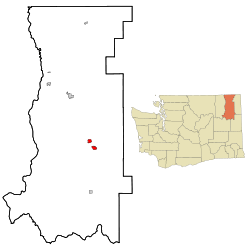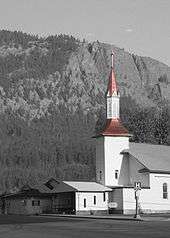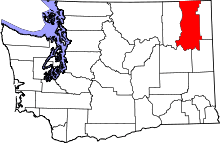Chewelah, Washington
| Chewelah | |
|---|---|
| City | |
| Chewelah, Washington | |
 Location of Chewelah, Washington | |
 Chewelah Location in the United States | |
| Coordinates: 48°16′34″N 117°42′51″W / 48.27611°N 117.71417°WCoordinates: 48°16′34″N 117°42′51″W / 48.27611°N 117.71417°W | |
| Country | United States |
| State | Washington |
| County | Stevens |
| Government | |
| • Mayor: | Dorothy Knauss |
| Area[1] | |
| • Total | 2.98 sq mi (7.7 km2) |
| • Land | 2.98 sq mi (7.7 km2) |
| • Water | 0 sq mi (0 km2) |
| Elevation | 1,667 ft (508 m) |
| Population (2010)[2] | |
| • Total | 2,607 |
| • Estimate (2015)[3] | 2,607 |
| • Density | 874.8/sq mi (337.8/km2) |
| Time zone | Pacific (PST) (UTC-8) |
| • Summer (DST) | PDT (UTC-7) |
| ZIP code | 99109 |
| Area code | 509 |
| FIPS code | 53-12140 |
| GNIS feature ID | 1517676[4] |
| Website |
www |

Catholic Church in Chewelah
Chewelah (/tʃəˈwiːlə/ US dict: chə·wē′·lə) is a city in Stevens County, Washington, United States. Chewelah was labeled Chiel-Charle-Mous on the 1897 U. S. Land Office Map. The population was 2,607 at the 2010 census which was a 19.3% increase over the 2000 census.[5]
History
The name of the town comes from a Kalispel word, sč̓ewíleʔ, meaning "watersnake" or "gartersnake".[6] Alice Sherwood Abrahamson[7] stated that "The name Chewelah comes from the Indian word "S che wee leh", meaning water or garter snake. There was a spring in what is now the southwest end of Chewelah. The old McCreas lived there, and their homestead was called "Sche wee leh ee" for the spring bubbled up there. The motion of the water gave the illusion of snakes moving about in the water." Prior to colonization by European-Americans, Chewelah was home to a band of the Kalispel people. The band was known as the slet̓éw̓si, meaning "valley people". Originally, the area was called Fool's Prairie, after the Kalispel Indian who left his own tribe because of a dispute.[8] Chewelah and the rest of the Colville River Valley were part of the Colville Indian Reservation from April 9, 1872, when the reservation was created, until July 2, 1872, when a subsequent executive order reduced the size of the reservation. The Chewelah Band of Indians is currently part of the Spokane Tribe.
Thomas and Mary Brown moved to the Fool's Prairie in 1859.[9] On May 8, 1872, Thomas Brown received authority to establish a post office named Chewelah. The name was first used in Stevens County Commissioner Journals on May 6, 1872.[10] That post office disbanded in February 23, 1875. In 1879, the post office was reestablished with Major John Simms, Indian Agent, as postmaster.[11] Chewelah was officially incorporated on February 4, 1903.
Chewelah is a town of firsts in Stevens County. It had the first Protestant Congregational Church in 1891, the first school in 1869,[12] the Spokane Falls and Northern Railroad arrived in 1889, a Catholic church was established in 1885, and the first county newspaper was founded in July 1885.[13]
Initially Chewelah was a typical pioneer settlement, being an agricultural center as far back as the early 1870s and having its share of prospectors working the adjacent countryside as early as 1842. The town was platted in 1884 and became known for being a rough and tumble mining town; the first lead and silver mines were established around 1886, and others followed in Embry and surrounding areas.
By 1905 the population had reached 650 souls, and within a few years many prosperous copper, silver, lead, and a few gold mines were flourishing in the area. The most successful ore mined in Chewelah was magnesite. This mineral was used for making bricks and furnace linings that could withstand high temperatures. Magnesite was also an important ingredient for making high-quality steel that was in high demand during World War I. Austria had previously been the main provider of magnesite for the country, but production was interrupted by the War. By 1916 Chewelah's plant was said to be the largest producer of magnesite in the country, and at full production was the largest producer in the world, shipping some 700 tons daily. During the war there were as many as 800 people working at the plant making high temperature-resistant refractory brick.
By 1920 Chewelah's population had grown to 1,600 people and continued to prosper until the late 1960s. In 1968 the magnesite plant closed down due to cheaper competition from Japan and changes in the steel industry. Despite this major change, Chewelah survived the transition from being a "one-company town," and today Chewelah has several thousand residents and displays a pleasant blend of the past and future. With its moderate climate, dry land, and irrigated farming, ranching and dairy farming continue to be mainstays. Chewelah's diversified economy also includes a ski area and golf course, among other industries.
Geography
Chewelah is located at 48°16′50″N 117°43′23″W / 48.28056°N 117.72306°W (48.280442, -117.722927).[14]
According to the United States Census Bureau, the city has a total area of 2.98 square miles (7.72 km2), all land.[1]
Climate
This climatic region is typified by large seasonal temperature differences, with warm to hot (and often humid) summers and cold (sometimes severely cold) winters. According to the Köppen Climate Classification system, Chewelah has a humid continental climate, abbreviated "Dfb" on climate maps.[15]
| Climate data for Chewelah | |||||||||||||
|---|---|---|---|---|---|---|---|---|---|---|---|---|---|
| Month | Jan | Feb | Mar | Apr | May | Jun | Jul | Aug | Sep | Oct | Nov | Dec | Year |
| Record high °F (°C) | 57 (14) |
62 (17) |
75 (24) |
91 (33) |
100 (38) |
106 (41) |
107 (42) |
110 (43) |
104 (40) |
92 (33) |
69 (21) |
58 (14) |
110 (43) |
| Average high °F (°C) | 33.9 (1.1) |
40.8 (4.9) |
49.2 (9.6) |
61.6 (16.4) |
69.4 (20.8) |
76.2 (24.6) |
86.6 (30.3) |
83.9 (28.8) |
75.5 (24.2) |
61.5 (16.4) |
45.5 (7.5) |
36.9 (2.7) |
60.1 (15.6) |
| Average low °F (°C) | 19.8 (−6.8) |
23.6 (−4.7) |
27.8 (−2.3) |
33.9 (1.1) |
40.3 (4.6) |
45.7 (7.6) |
51.9 (11.1) |
50.7 (10.4) |
45.5 (7.5) |
36 (2) |
28.3 (−2.1) |
23.8 (−4.6) |
35.6 (2) |
| Record low °F (°C) | −38 (−39) |
−38 (−39) |
−12 (−24) |
12 (−11) |
16 (−9) |
26 (−3) |
31 (−1) |
28 (−2) |
12 (−11) |
2 (−17) |
−19 (−28) |
−33 (−36) |
−38 (−39) |
| Average precipitation inches (mm) | 2.3 (58) |
1.74 (44.2) |
1.83 (46.5) |
1.44 (36.6) |
1.75 (44.4) |
1.66 (42.2) |
0.82 (20.8) |
0.8 (20) |
1.06 (26.9) |
1.47 (37.3) |
2.4 (61) |
2.9 (74) |
20.17 (512.3) |
| Average snowfall inches (cm) | 14 (36) |
8.4 (21.3) |
3.6 (9.1) |
0.4 (1) |
0 (0) |
0 (0) |
0 (0) |
0 (0) |
0 (0) |
0.4 (1) |
3.7 (9.4) |
11.8 (30) |
42.4 (107.7) |
| Average precipitation days (≥ 0.01 inch) | 12 | 9 | 10 | 9 | 10 | 9 | 5 | 5 | 6 | 9 | 12 | 13 | 109 |
| Source: [16] | |||||||||||||
Demographics
| Historical population | |||
|---|---|---|---|
| Census | Pop. | %± | |
| 1910 | 823 | — | |
| 1920 | 1,288 | 56.5% | |
| 1930 | 1,315 | 2.1% | |
| 1940 | 1,565 | 19.0% | |
| 1950 | 1,683 | 7.5% | |
| 1960 | 1,525 | −9.4% | |
| 1970 | 1,365 | −10.5% | |
| 1980 | 1,888 | 38.3% | |
| 1990 | 1,945 | 3.0% | |
| 2000 | 2,186 | 12.4% | |
| 2010 | 2,607 | 19.3% | |
| Est. 2015 | 2,607 | [17] | 0.0% |
| U.S. Decennial Census[18] 2015 Estimate[3] | |||
2010 census
As of the census[2] of 2010, there were 2,607 people, 1,150 households, and 690 families residing in the city. The population density was 874.8 inhabitants per square mile (337.8/km2). There were 1,284 housing units at an average density of 430.9 per square mile (166.4/km2). The racial makeup of the city was 93.1% White, 0.2% African American, 1.7% Native American, 0.5% Asian, 0.7% from other races, and 3.7% from two or more races. Hispanic or Latino of any race were 2.8% of the population.
There were 1,150 households of which 26.5% had children under the age of 18 living with them, 44.6% were married couples living together, 11.3% had a female householder with no husband present, 4.1% had a male householder with no wife present, and 40.0% were non-families. 35.6% of all households were made up of individuals and 18.7% had someone living alone who was 65 years of age or older. The average household size was 2.22 and the average family size was 2.85.
The median age in the city was 45.2 years. 23% of residents were under the age of 18; 5.6% were between the ages of 18 and 24; 21.2% were from 25 to 44; 25.7% were from 45 to 64; and 24.6% were 65 years of age or older. The gender makeup of the city was 46.6% male and 53.4% female.
2000 census
As of the census of 2000, there were 2,186 people, 911 households, and 562 families residing in the city. The population density was 743.0 people per square mile (287.1/km²). There were 1,004 housing units at an average density of 341.2 per square mile (131.9/km²). The racial makeup of the city was 92.96% White, 0.05% African American, 1.69% Native American, 0.69% Asian, 0.05% Pacific Islander, 0.91% from other races, and 3.66% from two or more races (also .01% Kari). Hispanic or Latino of any race were 2.70% of the population.
There were 911 households out of which 29.9% had children under the age of 18 living with them, 46.9% were married couples living together, 11.0% had a female householder with no husband present, and 38.3% were non-families. 33.4% of all households were made up of individuals and 18.6% had someone living alone who was 65 years of age or older. The average household size was 2.32 and the average family size was 2.98.
In the city the age distribution of the population shows 26.5% under the age of 18, 6.0% from 18 to 24, 23.1% from 25 to 44, 22.3% from 45 to 64, and 22.0% who were 65 years of age or older. The median age was 42 years. For every 100 females there were 89.8 males. For every 100 females age 18 and over, there were 82.0 males.
The median income for a household in the city was $25,238, and the median income for a family was $33,750. Males had a median income of $36,065 versus $18,938 for females. The per capita income for the city was $13,843. About 13.9% of families and 18.3% of the population were below the poverty line, including 19.9% of those under age 18 and 15.7% of those age 65 or over.
Schools
Events
- Chataqua (July 14–16, 2017) - Each year, on the second weekend in July, the town holds a festival known as Chataqua. It includes a parade, carnival, and craft fair.
- James Dean Days (Held on the first Saturday in August) - Car show and hot rod festival
Media
- Newspaper - The Independent
- Radio - KCHW 102.7 FM
Attractions
- Chewelah Casino, run by the Spokane Indian Tribe
- 49 Degrees North Ski Area, ten miles (16 km) east
- Chewelah Museum
- Chewelah Golf and Country Club 27-hole course
- Melody Riders Saddle Club
- Northern Meadows 4-H Club
- StageTime Theatre School
- Chewelah City Park
- Waitts Lake resort
- Chewelah Boy Scout Troop 998
- Chewelah Cub Scout Pack 998
- Chewelah Girl Scout 2236
Notable people
- David P. Jenkins, American Civil War cavalry officer and postbellum philanthropist.
- John R. Monaghan- United States Navy officer killed in action during the Second Samoan Civil War. He is the namesake of two ships USS Monaghan (DD-32) & USS Monaghan (DD-354).
- Albert Steelhead (b 1858), native of Sweden, became a pioneer photographer in Chewelah, Washington[19]
- Allen Stone- A soul musician who started his career in Chewelah
References
- 1 2 "US Gazetteer files 2010". United States Census Bureau. Archived from the original on 2012-01-24. Retrieved 2012-12-19.
- 1 2 "American FactFinder". United States Census Bureau. Retrieved 2012-12-19.
- 1 2 "Population Estimates". United States Census Bureau. Retrieved July 12, 2016.
- ↑ "US Board on Geographic Names". United States Geological Survey. 2007-10-25. Retrieved 2008-01-31.
- ↑ "2010 Census Redistricting Data (Public Law 94-171) Summary File". American FactFinder. United States Census Bureau. Archived from the original on 21 July 2011. Retrieved 17 September 2012.
- ↑ Bright, William (2007). Native American placenames of the United States. University of Oklahoma Press. p. 95. ISBN 978-0-8061-3598-4. online at Google Books
- ↑ http://www.crossroadsarchive.net/items/show/12888
- ↑ Drury, Clifford Merrill, First White Women Over the Rockies, Volume 2, Mary Walker's diary, September 11, 1842, page 235 and Chewelah Independent June 12, 1914, History of Chewelah, by Hilda Dickson. http://www.crossroadsarchive.net/items/show/12886
- ↑ Steele, Richard F. 'An illustrated history of Stevens, Ferry, Okanogan and Chelan counties, state of Washington', Spokane, Washington, Western Historical Publishing Company, 1904.
- ↑ Stevens County Commissioners Journal Book A, p. 168, 1860-1883.
- ↑ Ramsey, Guy Reed, 1960-66, Postmarked Washington: 1850-1960, pps. 1556-1157, viewed at Washington State Library, Olympia, July 23, 2013.
- ↑ "The Last Bell" by Alpa Naff, c. 1984 listed Pinkney City school established 1862 as the first public school in Stevens County.
- ↑ Slater, John B. comments on first newspaper in Stevens County. http://www.crossroadsarchive.net/admin/items/show/15324
- ↑ "US Gazetteer files: 2010, 2000, and 1990". United States Census Bureau. 2011-02-12. Retrieved 2011-04-23.
- ↑ Climate Summary for Chewelah, Washington
- ↑ "CHENEY, WASHINGTON (451395)". Western Regional Climate Center. Retrieved November 16, 2015.
- ↑ "Annual Estimates of the Resident Population for Incorporated Places: April 1, 2010 to July 1, 2015". Retrieved July 2, 2016.
- ↑ United States Census Bureau. "Census of Population and Housing". Archived from the original on May 11, 2015. Retrieved October 4, 2013.
- ↑ Steelhead, Albert (Photographer) (April 21, 2008). "Photo of the Week". Shades of the Departed.
External links
- Official website
- Chewelah Chamber of Commerce
- History of Chewelah at HistoryLink
- Chewelah: a community wiki page of the Stevens County Wiki Project
- Chewelah Independent newspaper serving the community since 1903
- Stevens County and Chewelah Museum historical records
- Community Celebrations's Chataqua festival

